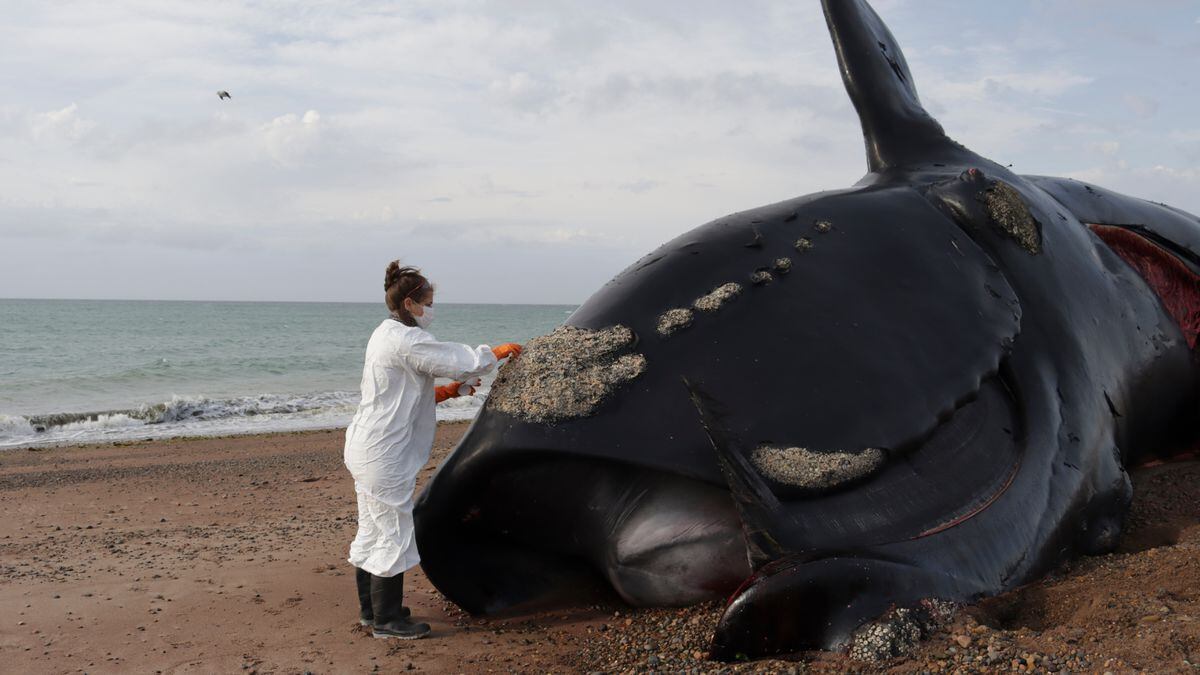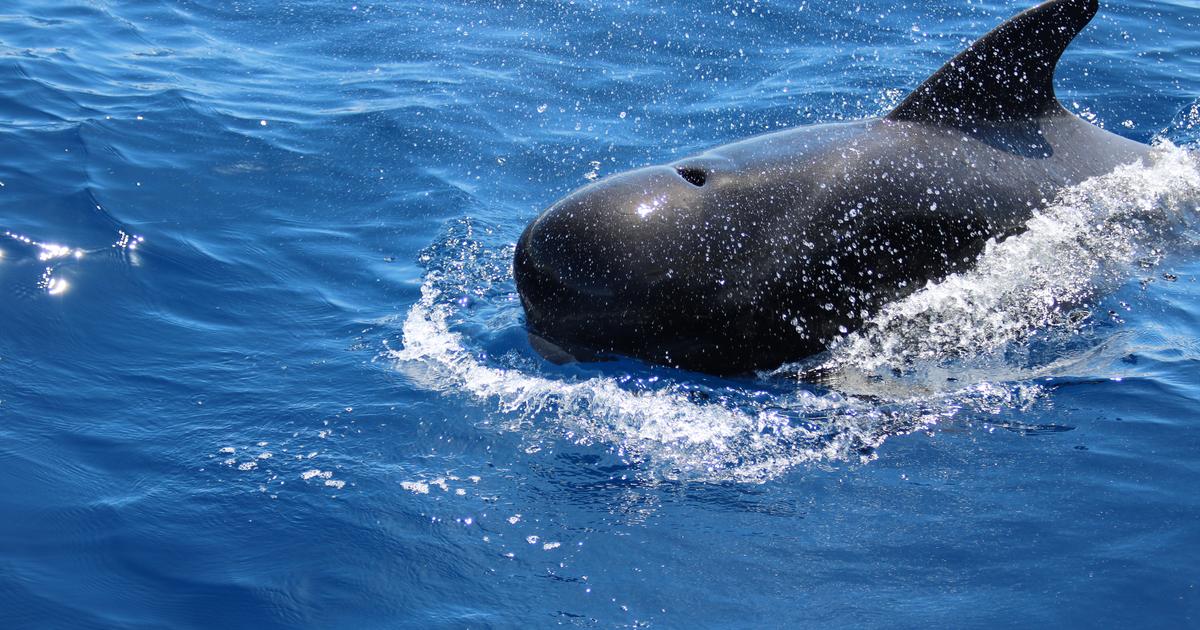A researcher analyzes the carcass of a dead whale on a beach on the Valdés Peninsula, in the province of Chubut (Argentina), on October 15, 2022. PMSBFA - ICB (PMSBFA - ICB / EFE)
EL PAÍS offers the América Futura section openly for its daily and global informative contribution on sustainable development.
If you want to support our journalism, subscribe
here
.
The first alert was given on Saturday, September 24.
In Punta Pardelas, located in the Nuevo Gulf of the Valdés Peninsula (Argentina), a dead adult whale was found.
Then more appeared: five, ten, 18 cases.
Two weeks later, after making an aerial flight over the area, the Southern Right Whale Health Monitoring Program (PMSBFA) reported a total of 30 dead whales: 26 adults and four juveniles.
It was a worrying figure: not only were there several deaths at the same time, but they had also happened in that particular gulf, in the province of Chubut, which is a natural area, one of the regions with the highest concentration of marine mammals in the world and where The southern right whales go to reproduce and have their young.
The immediate suspicion was red tide.
This was indicated by the samples of plankton and bivalves (molluscs) that were taken in the area.
This was later confirmed by the bodies of the whales.
After performing a necropsy on nine of them, researchers from the Whale Conservation Institute said they had detected "paralytic shellfish toxin" in various tissues of five of the whales.
They concluded that they had died due to a harmful algae bloom, popularly known as red tide.
"These blooms affect some organisms and not others," explained Dr. Marcela Uhart, co-director of the PMSBFA in a statement.
"For example, bivalves such as mussels and mussels are not affected and act as concentrates and vectors, making it easier for the toxins to pass to other higher organisms in the food chain."
“Some toxins have paralyzing properties and affect the respiratory system, and can cause death by suffocation.
Others affect the gastrointestinal and nervous systems,” she added.
In the case of whales, says Alejandro Arias, a specialist in Marine Coastal Landscapes at Fundación Vida Silvestre Argentina, they are affected because they directly "eat" the plankton.
“Whales are filter feeders.
That is to say, they directly filter the plankton and, if it has these toxic conditions, it causes death”, assures the member of this organization who, at the time, facilitated access to several researchers so that they could enter the beaches of the San Pablo de Valdés Wildlife Reserve, in Chubut, to carry out the analyses.
Although red tide deaths are not new, the case of the 30 whales is "absolutely extraordinary."
This is how Nora Montoya, head of the Marine Chemistry and Red Tide Program of the National Institute for Fisheries Research and Development of Argentina (INIDEP), defines it.
She remembers that the first time they experienced the consequences of the red tide it was "quite tragic".
“In 1980 a fishing boat that was precisely in front of the Valdés peninsula, where the death of whales now took place, took mussels to consume them.
Two crew members were poisoned and died.
A group of researchers walks next to the body of a whale, in the province of Chubut, on October 15, 2022. PMSBFA - ICB (PMSBFA - ICB / EFE)
Since then, Argentina has deployed a control and monitoring system.
Health authorities trace the shellfish to certify that they do not contain biotoxins, a plan that has been mostly successful.
“The last reported death of a human from red tide was in 2011. Some people ate uncontrolled mussels in the San Jorge Gulf area despite the fact that the lifeguard warned them that there was a red tide and that they could contain toxins.
But they did not listen: three people were intoxicated and one did die.
But Montoya's program is even more complex, since it consists of investigating how frequent red tides are, how they affect the environment and what impact they have on other organisms.
Along with the 30 whales, for example, the death of birds, penguins and a sea lion were also reported.
"There are always sporadic cases, but to a much lesser extent than what we are seeing now," he says.
And it is that in general, he comments, worldwide it has been observed that these are becoming more frequent and more intense due to certain human activities.
A study published in the scientific journal
Harmful Algae
, in which it was explored how the records of toxic phytoplankton and associated toxins had increased in water samples from the Argentine Patagonian platform —of which the Valdés Peninsula is part— between 1980 and 2018 , found that, indeed, the records increased from 124 for the period between 1980-1992 to 638 in 2006-2018.
This, of course, is related to the fact that the alert for red tides has increased and, as a result, more samples have been taken to explore them.
However, the document also explains that changes related to the ocean climate, such as more frequent storms and marine heat waves, as well as pollution, have caused toxic algae outbreaks “more frequent and serious”.
The Southwest Atlantic region, moreover, "has been identified as a hot spot where sea surface temperature increases more rapidly compared to other regions."
This does not mean that it is known – at least not yet – what was the exact cause that promoted the red tide that killed the 30 whales and other animals.
As Luisina Vueso, coordinator of Greenpeace Argentina's oceans campaign, points out, climate change could play a role.
“Among the many ecosystem services provided by the sea is that of absorbing excess heat generated by climate change.
However, this implies that the seas themselves warm up and start to collapse, ”she notes.
In addition to this global crisis, the local panorama of the region is added, such as events such as the phenomenon of La Niña or El Niño.
"But to be able to affirm all these hypotheses we must carry out studies and that is what we are working on at the moment," recalls Montoya.
Something in which there is a clearer signal, he adds, is that red tides in that area usually occur between October and November.
This time, however, the outbreak arrived in September, just when the whales were still in the region to complete their reproduction and feeding cycle, since it is around October when they begin to migrate to other parts of the world.
"Then it coincides that the red tide is coming, which was very intense, and the whales had not begun to retreat," he comments.
And although it is a tragedy, Vueso, from Greenpeace, believes that it can help to put an essential issue back on the agenda: the protection of the seas, especially in international zones, in territories that do not belong to any country, but are all at once.
The Gulf of Valdés, for example, is an area protected by your country, where the PMSBFA monitors the whales.
But China's climate policies or the pollution that occurs in the open sea, in no man's land, also affects it.
"The sea is a common good that remains unprotected," he says.
"And the death of these right whales, an iconic animal, helps put into perspective the need for real, international policies to protect the seas."







/cloudfront-eu-central-1.images.arcpublishing.com/prisa/LRSWMXRGLREYHO2C6YULM5WE5M.jpg)
